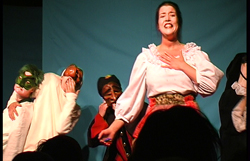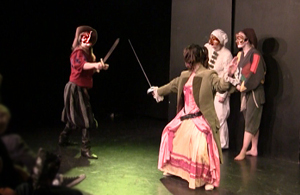The second group of strategies he call dividing the stage:
- Windows are the easiest way to divide the stage. By using windows on the backdrop (as talked about in THE STAGE), where a mask can look out, we work on height. The mask in the window is also fixed to one place on stage. The mask in the window can on his own decide whether he is seen of the others or not, by using or not using reactions to what is happening down on the stage.
- Stepping back is when one or more masks steps back to one upstage corner where they are passive onlookers to the action on stage. This convention allows the masks upstage not being seen by the other masks. They must be very careful not using to big reactions.
- Tunnel vision is a convention where a mask makes an entire without seeing or registers the other masks. This way he has a separate moment with the audience before Interacting with the other masks. The masks that are already on stage can choose to see him and react to him, ignore him or not see him at all. The mask that not is seen does not exist for the other masks. Like in the classic scene when two Innamorati run around looking for each other on the same stage.
- Private confabs allow a mask to bring another mask to the side of the stage to have a confidential conversation. There they can talk without the other masks hearing or observing them. They take down their movements and act as if they didn’t see or hear the masks on the side. It may also work for to masks just to bend down and act in another level, when they for example stand in between other masks.
- Parallel actions are when we have to actions going on at the same time. They are always autonomous and work as sovereign actions on stage. But they are still depending on each other either they contrast each other or they work simultaneous. One of the most common examples is when two Innamorati have each monologue saying the same things with different words or contrasting each other without seeing each other.
- Asides are the classical aparte lines when a mask simply takes a step out (or even just a turn of the head) to the audience for a brief moment and addresses them. The rest of the action on stage stops so that the actor doing the aside doesn’t have to deal with the other masks during his aparte.
Other related posts about Commedia dell’Arte is:
The content in Commedia dell’Arte
The roots to all popular western comedy
Commedia dell’Arte lecture
Back to PART 1

